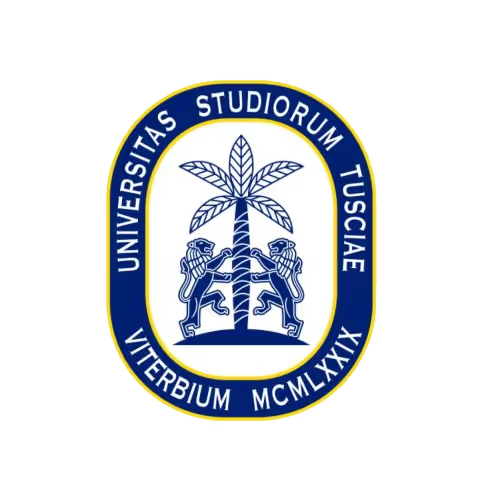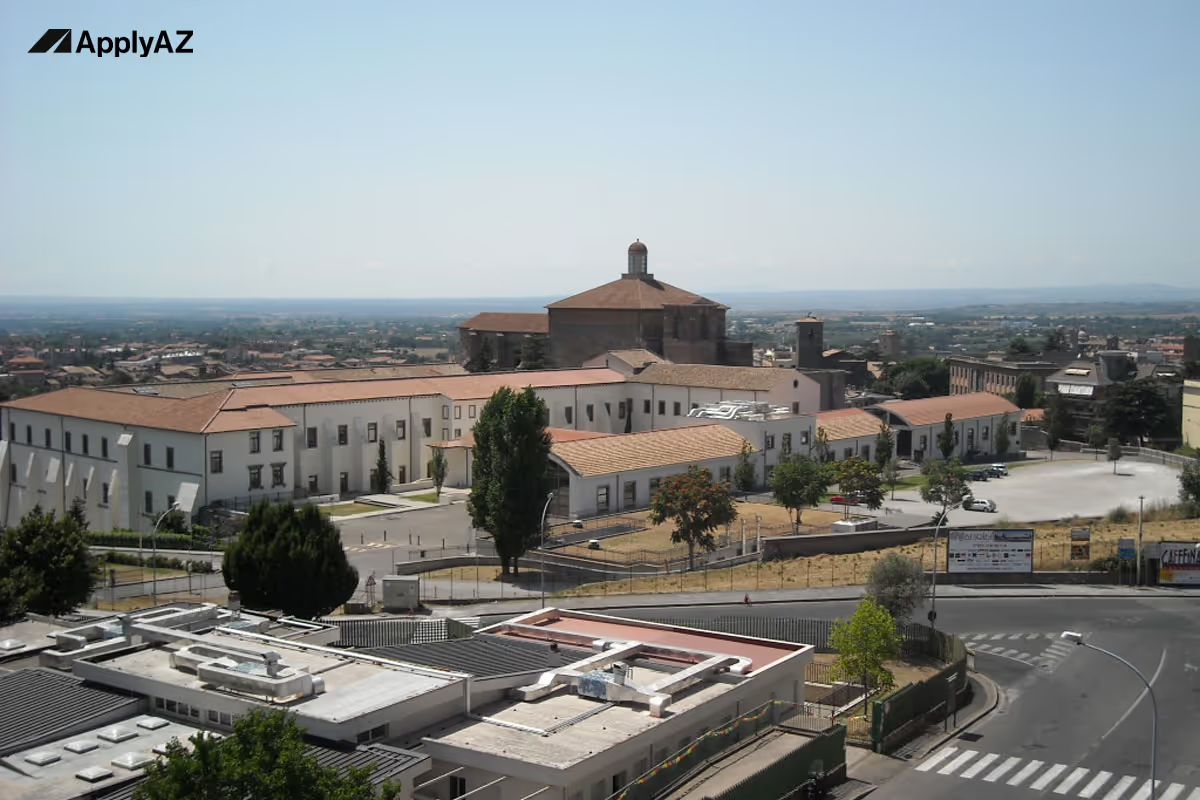Heading
Heading








University of Tuscia (Università degli Studi della Tuscia)
English-taught programs in Italy are booming, and the University of Tuscia (Università degli Studi della Tuscia) is part of that growth. Here you study in Italy in English, pay the low fees typical of tuition-free universities Italy, and enjoy the academic standards found across public Italian universities. Founded in 1979, Tuscia focuses on agri-food science, forestry, circular economy, and cultural heritage—fields that match the volcanic landscapes, Etruscan ruins, and bio-economy clusters of its home city, Viterbo.
A young public Italian university with deep local roots
Tuscia began as a network of small faculties housed in Renaissance cloisters. It now hosts six departments:
- Agriculture and Forestry Sciences
- Ecological and Biological Sciences
- Economics, Engineering, Society and Business
- Linguistics, Literature, History, Philosophy and Heritage
- Innovation in Biological, Agro-food and Forestry Systems
- Law and Social Sciences
The university ranks in the global top 400 for Agriculture and Forestry (QS 2025) and appears in the Times Higher Education Impact Rankings for Climate Action. Researchers advise FAO and UNESCO on food security and heritage conservation. With seminar groups rarely larger than 30 students, you work directly with professors on lab projects, field surveys, and peer-reviewed papers.
What you can study in Italy in English
Current English-taught degrees include:
- Circular Economy and Sustainable Tourism
- Forestry and Environmental Sciences
- Food Science and Technology
- Cultural Heritage – From Field to Digital
All follow the Bologna Process, so you can transfer credits or progress easily to European master’s programmes.
Viterbo: a medieval city that doubles as a living lab
Everyday life and affordability
Viterbo is a walled city of 65 000 residents, one hour north of Rome by train. Cobblestone lanes, natural hot-spring baths, and student cafés keep life relaxed and affordable.
- Housing: €260–350 per month for a single room in a shared flat.
- Meals: Mensa lunch costs €4.50 for pasta, salad, and fruit.
- Transport: A €20 monthly bus pass covers the city and nearby lakes.
- Climate: Winters hover around 6 °C; summers reach 30 °C but cool at night—perfect for outdoor study sessions.
Culture and leisure
- UNESCO-listed Macchina di Santa Rosa festival each September.
- Weekly farmers’ markets selling local hazelnuts and volcanic-soil vegetables.
- Romanesque churches, Etruscan tombs, and free museum nights.
Free Italian courses and tandem-language cafés help you integrate while keeping English as your study medium.
How the DSU grant helps
- Full fee waiver
- Free housing or rent allowance
- Two daily meals in canteens
- €1 700 yearly stipend for books and local travel
About 70 % of eligible applicants receive funding. ApplyAZ advisers guide you through translations, legalisations, and online forms.
Other options:
- Tuscia Merit Scholarship (€5 000) for top entrance-test scores
- Erasmus+ mobility grant (€400–500 per month)
- Ministry of Foreign Affairs scholarships for selected countries
Learning model: fieldwork, labs, and industry briefs
Hands-on classes
- Soil microbiology: collect samples in chestnut groves, analyse DNA in campus labs.
- Digital archaeology: 3-D scan Etruscan sites and build virtual tours.
- Circular-economy design: prototype bioplastic products in the FabLab.
Real-world projects
Professors embed consultancy tasks from local partners:
- Map drought risks for Acea (regional utility).
- Optimise hazelnut supply chains for Ferrero.
- Design visitor-flow dashboards for Lazio tourism board.
These projects add measurable impact to your CV.
Job and internship landscape
Key industries around Viterbo
- Agri-food and horticulture (hazelnuts, wine, olive oil)
- Forest management and biomass
- Cultural-heritage tourism and restoration
- Renewable energy (geothermal, solar)
Major employers
- ENEA Casaccia Research Centre (energy transition)
- Lazio Innova hub (agritech start-ups)
- Fiera di Roma (trade-fair organiser needing event analysts)
Non-EU students can work 20 hours weekly during term, full-time in breaks, easing living costs and building networks.
Graduate pathways
Tuscia alumni move on to:
- MSc in Plant Biotechnology at Wageningen University
- Erasmus Mundus master in Forestry Science (SUFONAMA)
- PhD in Cultural Heritage at the European University Institute
- Analyst roles at FAO headquarters in Rome
Employability stands at 88 % within one year (AlmaLaurea 2024), thanks to skills in field data, sustainability reporting, and digital heritage.
Why choose the University of Tuscia and Viterbo
- Quality teaching focused on green and heritage sectors.
- Affordable living in a historic yet student-friendly city.
- English-taught flexibility with free Italian support.
- Hands-on research that tackles climate, food security, and culture.
- Easy train link to Rome for internships and flights home.
Together they offer a balanced, inspiring, and budget-friendly route to a European degree.
In two minutes we’ll confirm whether you meet the basic entry rules for tuition-free, English-taught degrees in Italy. We’ll then quickly see if we still have space for you this month. If so, you’ll get a personalised offer. Accept it, and our experts hand-craft a shortlist of majors that fit your grades, goals, and career plans. Upload your documents once; we submit every university and scholarship application, line up multiple admission letters, and guide you through the visa process—backed by our admission-and-scholarship guarantee.
Design at University of Tuscia
Design touches every part of modern life—furniture, apps, packaging, and even public policy. If you want to shape those experiences, the Design bachelor (class L-4) at the University of Tuscia (Università degli Studi della Tuscia) gives you the tools. This programme ranks among the most forward-thinking English-taught programs in Italy. You study in Italy in English, enjoy the progressive fees found at tuition-free universities Italy, and graduate from a respected public Italian university set in the medieval city of Viterbo. Professors blend Italian craft traditions with digital fabrication, turning a small campus into a lab for sustainable and social design.
1 | Why study design in Viterbo—and why now?
Rising demand for green and human-centred designers
Global brands seek creatives who can turn climate goals and social needs into tangible products and services. Tuscia’s Design degree focuses on circular materials, inclusive interfaces, and community co-creation—skills employers crave. The programme sits within the Department of Innovation in Biological, Agro-food and Forestry Systems, known for EU-funded research on bio-based materials. That connection means design students experiment with mushroom mycelium leather and olive-pit biomaterials long before they hit mainstream studios.
Small-cohort learning
Unlike big city academies, Tuscia limits cohorts to about thirty students. You get continual feedback from lecturers who publish in Design Issues and serve on Sustainable Development Goals panels. Peer critiques happen in restored Renaissance cloisters—uncommon inspiration for your sketchbooks.
Lower living costs, richer lifestyle
Viterbo rents hover around €300 a month for a room in a shared flat; espresso still costs €1.30. Hot-spring pools, Etruscan ruins, and chestnut forests fill weekends without draining your wallet or carbon budget. A train reaches Rome in eighty minutes for design fairs and internships.
2 | Course blueprint: from hand sketches to circular-economy systems
The Design bachelor spreads 180 ECTS across six semesters. All core modules are taught in English; optional Italian classes support daily life.
Year 1 – Foundations (60 ECTS)
- Drawing and visual language
- History of design and art
- Fundamentals of sustainable materials
- Digital photography and Adobe Creative Cloud
- Geometry and descriptive drawing
- Introduction to user-centred research methods
Group micro-project: redesign campus signage for way-finding clarity using only recycled wood and biowash inks.
Year 2 – Digital and material thinking (60 ECTS)
- Interaction design and basic coding (HTML, CSS, JavaScript)
- Product design studio: modular furniture for micro-apartments
- Eco-materials science: biomaterials, recycled polymers, and life-cycle analysis
- Service design: mapping user journeys for local transport
- Ergonomics and inclusive design
- Fabrication lab with 3-D printing, CNC milling, laser cutting
Field mission: collaborate with a ceramic workshop in nearby Civita Castellana to prototype low-energy glazing.
Year 3 – Integration and professional practice (60 ECTS)
- Business models for creatives: pricing, IP, and crowdfunding
- Social innovation studio partnered with NGOs working on refugee inclusion
- Electives: data visualisation, wearable technology, food-system design, audiovisual storytelling
- Six-month internship and thesis project
Past theses: a furniture line made from vineyard pruning waste; an AR mobile guide for Etruscan archaeology; an inclusive playground redesigned with local families and disability advocates.
Continuous assessment—portfolios, project exhibitions, and soldered prototypes—replaces most written exams. Students leave with industry-ready portfolios and a network of regional artisans and tech incubators.
3 | Learning facilities: old walls, new tech
- FabLab Tuscia – houses Ultimaker printers, Formlabs resin machines, a ShopBot CNC router, industrial sewing machines, and Arduino starter kits.
- Biomaterials Lab – shared with agriculture students; test tensile strength of mycelium panels or algae-based bioplastics.
- VR/AR Studio – HTC Vive headsets and Unity licences for spatial-experience prototyping.
- Library in S. Maria in Gradi monastery – design monographs, material swatches, and quiet cloisters open past midnight during portfolio deadlines.
Guided shop-safety courses grant you tool access from the first semester. Assistant technicians help translate sketches into laser-cut joints or code into interactive installations.
4 | Internship ecosystem: local craft meets digital industry
Viterbo province
- Ceramics hub (Civita Castellana) – companies need pattern designers and 3-D modellers.
- Wood furniture cooperatives – prototype small-batch furniture using FSC timber.
- Cultural heritage agencies – design AR apps to interpret Etruscan tombs or medieval frescoes.
Rome design scene
Fast trains bring you to Rome’s digital-agency clusters and fashion houses in eighty minutes. Past interns:
- Built motion-graphics for Fendi’s environmental campaign.
- Designed store layouts for IKEA’s Italian sustainability pilot.
- Helped ACEA utility visualise water-consumption dashboards.
Global edge
Through Erasmus+, students spent semesters at Aalto University’s Design Factory, the Copenhagen School of Design and Technology, and TU Delft’s Industrial Design Engineering faculty, adding European scope to their portfolios.
5 | Career outcomes and postgraduate routes
AlmaLaurea 2024 data report 89 % employment or master’s enrolment within one year. Typical roles:
- UX/UI designer in start-ups
- Product designer for furniture brands
- Sustainable-materials researcher
- Service-design consultant for public agencies
Graduates often enter Master of Arts programmes at Politecnico di Milano, Lund University, or the Erasmus Mundus Design for Sustainability consortium, buoyed by Tuscia’s strong recommendation letters.
Starting salaries average €29 000 in Italy and €38 000 in northern Europe. Alumni network sessions connect you to peers at IDEO, IKEA, and Circular Design Lab Berlin.
6 | Soft-skill builders and student societies
- Design Critique Club – weekly peer reviews under café string-lights.
- Circular Fashion Society – upcycle waste textiles into capsule collections.
- Hack4Heritage – 48-hour sprint turning archaeological datasets into VR exhibits.
- Beekeeping lab – study biomimicry by maintaining rooftop hives.
These groups hone leadership, pitching, and community-engagement skills, essential for modern designers.
Ready for this programme?
If you qualify and we still have a spot this month, we’ll reserve your place with ApplyAZ. Our team will tailor a set of best-fit majors—including this course—and handle every form and deadline for you. One upload, many applications, guaranteed offers, DSU grant support, and visa coaching: that’s the ApplyAZ promise. Start now and secure your spot before this month’s intake fills up.

They Began right where you are










